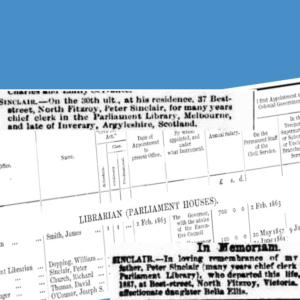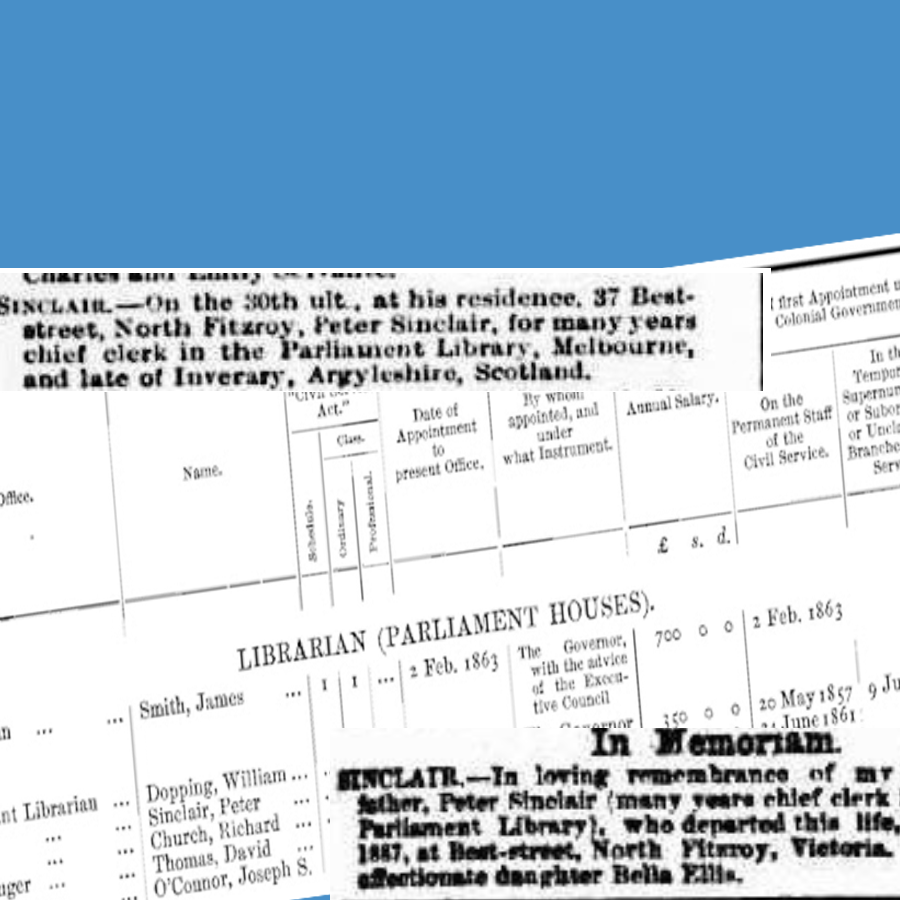Alex Daw, blog author of Family Tree Frog, has shared this blog as part of our ongoing “How I Solved It Series”. 
Alex revisits a previous blog on the family that included information and a warning to be careful of certain indexes. So she avoided those indexes at first and went for a newspaper. That set off her discovery of his death, his occupation and, when she ordered his death certificate, his parents.
| Greenham Studios. (1901). Victorian Parliament House, Federal Parliamentary Library, Melbourne, [1920?] Retrieved January 30, 2017, from http://nla.gov.au/nla.obj-136761356
Libraries are my happy place. So you can imagine how pleased I was last weekend when I discovered that one of my ancestors worked in this fabulous looking place in the 19th century.
How did I discover this? Well, I was mucking around, as you do, trying to be a good family historian. I had received an email from the Lost Cousins mob and was trying to add more ancestors and their households to the site. I knew my Sinclairs had come out from Scotland and was trying to remember when and then trying to find relatives in the 1881 Census. I didn’t have much joy in that regard but in the process reminded myself of some earlier research I had done here. Do you use your blog to remind you of previous research conducted? I do all the time. Thank goodness I have a search bar on my blog. It is my lifesaver- my back-up brain as it were. Family Notices (1888, January 26). The Australasian Sketcher with Pen and Pencil (Melbourne, Vic. : 1873 – 1889), p. 15. Retrieved January 30, 2017, from http://nla.gov.au/nla.news-article63225625
|
- Bella 43
- Anne 40
- James 38
- Helen 36
- Emma 32
Jolly good.
“Melbourne Cemetery” I thought to self – “I wonder where that is?”
This is where it is timely as a Family Historian to actually look at what you are reading and SLOW DOWN. I’m not very good at that. Do as I say, not as I do.
I got all distracted by this page….when really I should have been looking at this page .Never mind. It got me off my bottom and off to the QFHS at Gaythorne which had the Marjorie Morgan book mentioned on the Old Melbourne Cemetery page and better still, the CD-ROM published by the GSV and AIGS Melbourne General Cemetery: index and transcriptions of Melbourne General Cemetery monumental inscriptions to 1989.
I searched under the surname Sinclair and then narrowed it down to all the Peter Sinclairs and found my family. I was a bit confused at first because the headstone had ROACH on the top of it rather than SINCLAIR. But then I realized that the youngest daughter Emma’s married name was ROACH. From the headstone I found out who all the other children married and/or when they died.
Yes, I also tracked down Peter’s will and probate on the PRO site. That was all free to download – yay! Peter basically left everything to his wife and then in the event of her death, it was to go to his unmarried daughters and son. Son James died in 1895. Wife Isabella died in 1891. Daughter Helen Sinclair applied to the Supreme Court to administer the estate in 1901 declaring that the only persons entitled to a share in the distribution of the estate were sisters Anna and Emma. Their eldest sister Isabella was still alive at that time but perhaps they considered she was well provided for and indeed, I have to agree when I reflect on her probate as discussed in this post here.
Anyway, that’s not important in the scheme of things. I really would like to find out more about their father Peter and what led him to be Chief Clerk at the Library. I wonder what he actually did as Chief Clerk.
Here’s a map of where he lived and worked and was buried.
[googlemaps https://www.google.com/maps/embed?pb=!1m18!1m12!1m3!1d25220.234453341054!2d144.96038778448278!3d-37.80106928298208!2m3!1f0!2f0!3f0!3m2!1i1024!2i768!4f13.1!3m3!1m2!1s0x6ad6432c6ccfce29%3A0xf045676053053e0!2sMelbourne+General+Cemetery!5e0!3m2!1sen!2sau!4v1486132477661&w=600&h=450]
I’ve looked him up in various directories and have managed to plot a bit of a timeline.
From about 1867 there is a Peter Sinclair living in Napier Street Fitzroy (later clarified to be number 54) and he seems to move to Best Street in about 1884.
According to the Blue Book of 1867 which I found online here,
Peter was appointed to the position of Clerk on 24 June 1861. His annual salary was £250. He still seems to have been clerk according to a directory in 1871 at the age of 69. So he would have worked for Librarians Charles Ridgway and James Smith. I wonder how he obtained this position. Previously, on his daughter Isabella’s marriage certificate he was described as a contractor.
That could mean anything really yes?
A bit more digging on Trove and I found a couple of articles which indicated how the position might have become available. It seems that there was a young book-sewer by the name of Jessie Gallie who fell pregnant with the assistance of Alfred Britter, a clerk in the Parliamentary Library. According to the morals of the time, she lost her job due to her condition and was forced, through destitution, to take him to court for maintenance. If you want to get a sense of the times this article and this article will enlighten you. I suspect Mr Britter didn’t suffer too much though and that he was just moved sideways into the Post Office according to this article – sigh.
What would it have been like working in the Parliamentary Library I wonder?
This article gives us some idea.
 |
| MELBOURNE. (1862, December 12). Bendigo Advertiser (Vic. : 1855 – 1918), p. 2. Retrieved February 4, 2017, from http://nla.gov.au/nla.news-article87904272 |
I’ll never complain about my job again!
Sue Reynolds in her paper Libraries, Librarians and Librarianship in the Colony of Victoria quotes Patrick Gregory who wrote a history of the Library as saying:
“that the true work of the library was performed by the Committee, with Ridgway (the Librarian) the “fetcher and carrier” who had “little to do with the development of the collection, a task that fell to the Committee and its London agents…his work consisted more of checking the inventories against the contents of ever-increasing number of creates, cataloguing the unpacked books and doling them out to members.”
Dr. Diane Heriot’s paper Integrated Library and Research Services in the Australian Parliament here quotes Biskup and Goodman:
“Parliamentary libraries grew up in the nineteenth century tradition of the cultured gentlemen’s library and were, for many years, little more than well-appointed clubs where members could read their favourite newspapers and find the occasional literary allusion or quotation for speeches.”
If you are interested in the history of the Parliamentary Library in Melbourne, click here and here. There is also an online exhibition celebrating 100 years of the National Library archived in Pandora here.
Next time I go to Melbourne I am going to have some fun aren’t I?
If you have a story idea or a blog that you’d like to share as part of this series, please let us know about it in the comments.






“Do you use your blog to remind you of previous research conducted?”
Yes, all the time. Many of my blogs are meant to be records for myself of my own research, putting all the pieces in one place.